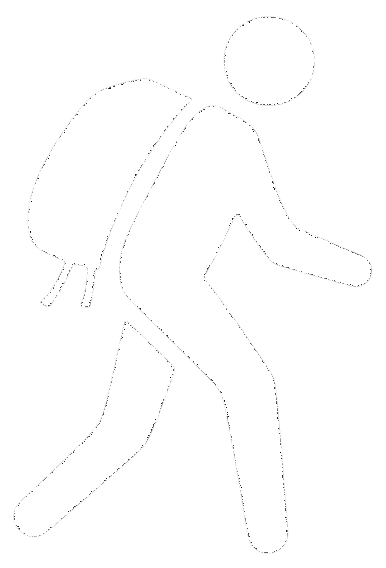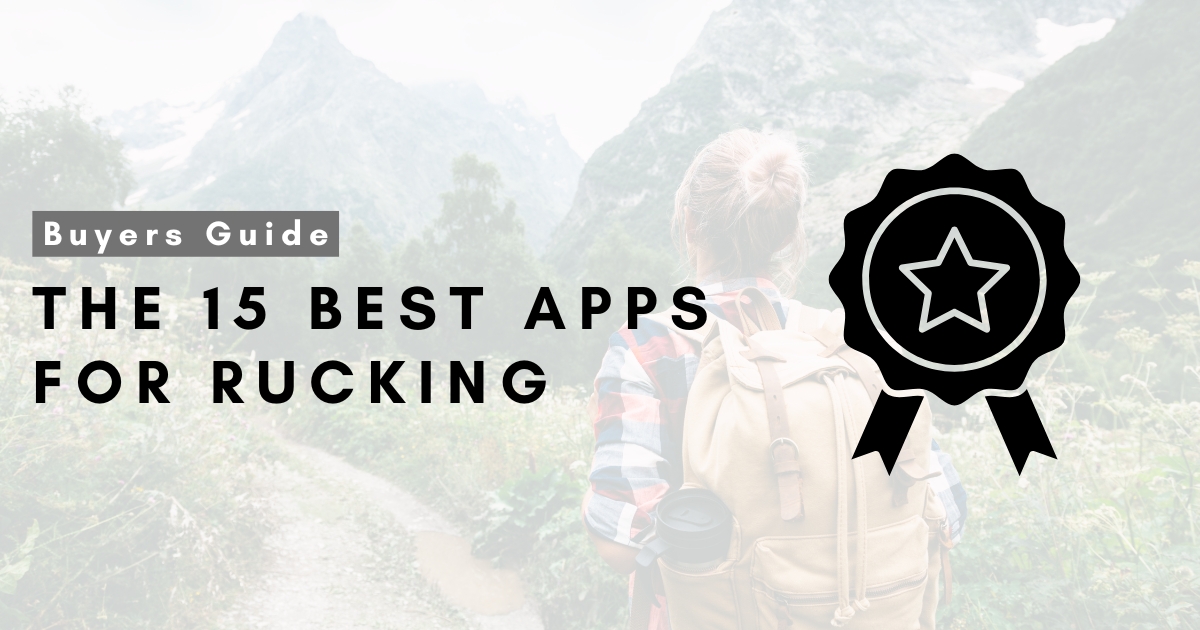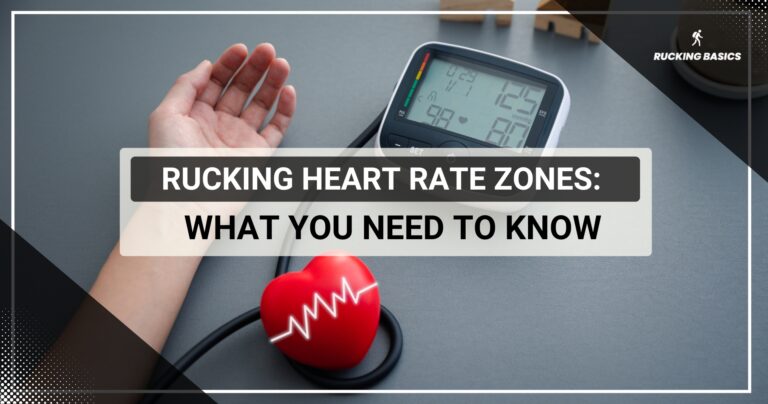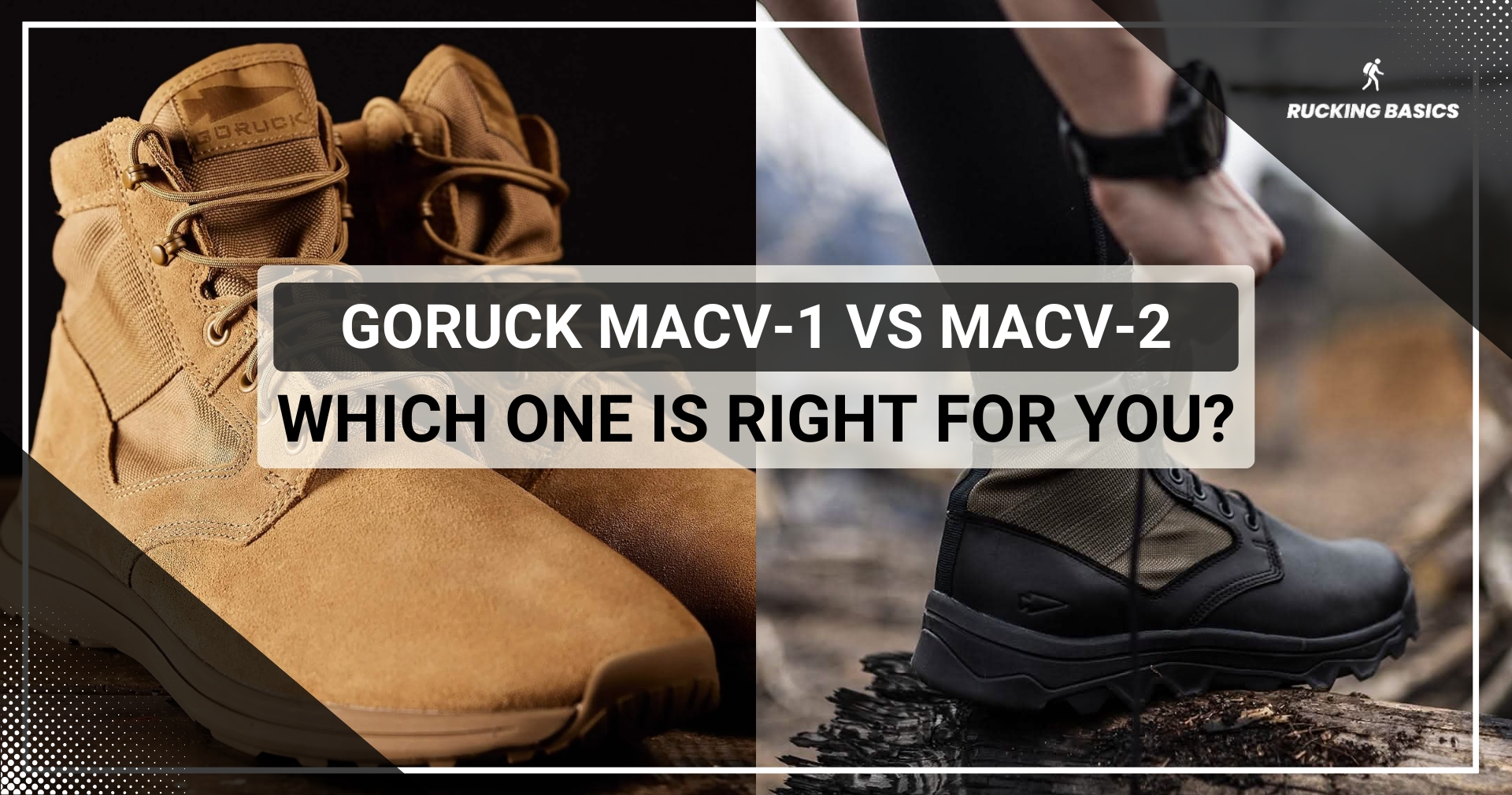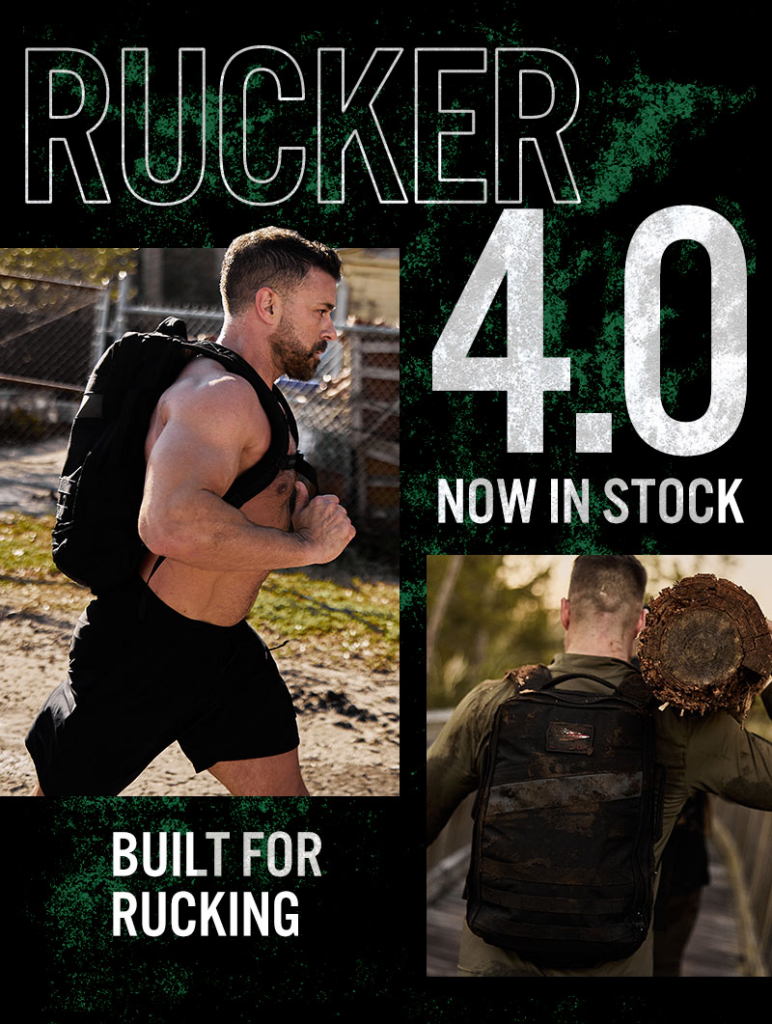Having a dedicated app for your rucking sessions can drastically improve your performance, gather invaluable insights about your body, and even prevent certain injuries. However, with the market full of apps, it’s rather difficult to single out the best apps for rucking.
I took some time off, around 48 hours in total, to research, evaluate, and single out only the best rucking apps on the market. Many of these apps offer similar features, while some come with advanced options that can radically transform your view on rucking sessions.
Let’s jump straight into reviews and hopefully find the best app for rucking according to your current needs and personal goals.
Best Apps for Rucking
- Best Overall: AllTrails
- Best for Community Engagement: Strava
- Best for Detailed Tracking: Map My Walk / Map My Run
- Best for Offroad Adventures: Onx Offroad
- Best for Creative Documentation: Relive
- Best for Goal-Oriented Ruckers: Runkeeper
- Best for Recovery Insights: Whoop
- Best for iOS Users: Apple Health
- Best for Samsung Device Users: Samsung Health
- Best for Athletic Performance: Nike Run Club
- Best for Community and Coaching: Tribes N’ Training
- Best for Minimalist Ruckers: Street Parking
- Best for Flexibility and Core Strength: Pliability
- Best for Heart Health Monitoring: Cardiogram
- Best for Local Fitness Communities: Sandlot
Best Apps for Rucking 2024 Reviews
Here are unbiased reviews of the best rucking apps.
Best Overall: AllTrails
When it comes to rucking, the path you choose can make all the difference in your workout. That’s where AllTrails comes in as a game-changer for outdoor enthusiasts. Having spent countless hours on this app exploring hidden trails and planning my next adventure, it’s about time I share my insights with you.
One of the most impressive features of AllTrails is its extensive database, boasting over 200,000 trails. This means no matter what kind of scenery you’re in the mood for, you’re likely to find a trail that fits the bill. From serene walks in the park to challenging mountain rucks, AllTrails has it all.
Before you set out, the app provides detailed information about each trail, including difficulty levels, elevation gain, and user reviews. This has been invaluable for me, helping me avoid trails that might be too challenging or not challenging enough. Another aspect of AllTrails that I’ve found particularly useful is its ability to track and record hikes.
The app keeps track of your distance, elevation gain, and even calories burned. Looking back at the trails I’ve conquered over time has been incredibly rewarding, and it’s a great motivator to keep pushing my limits. The depth of trail information and user feedback provides a level of preparedness that’s hard to match.
Although the Pro version comes with a subscription fee, the benefits it offers can be worth the investment for those who ruck regularly and are always on the lookout for new trails to explore. However, if your rucking is limited to familiar paths, or you prefer not to pay for additional features, the free version of AllTrails may suffice for your needs.
Pros
- A User-friendly interface makes searching and filtering trails effortless.
- Community reviews and photos provide a real-world glimpse into trails.
- Offline maps are essential for areas with unreliable cell service.
Cons
- Some less-traveled or new trails might not be listed in the app.
Best for Community Engagement: Strava
Strava is basically a vibrant community for athletes, including ruckers. My experience with Strava highlighted its unique blend of tracking, competition, and social networking, making each ruck not just a workout but a shared adventure.
The app excels in motivating users through competitive segments, comparing your efforts against both your past performances and those of the wider community. This feature has consistently pushed me to improve, adding an enjoyable competitive edge to my rucking.
I believe that Strava is perfect for ruckers keen on a social and competitive twist to their workouts. Its ability to connect users and track various activities makes it a versatile choice for multi-sport athletes.
However, if you’re more into rucking for solitude, Strava’s social features might not appeal as much. Despite this, its comprehensive tracking capabilities and seamless wearable integration make it a solid choice for enhancing your fitness journey.
Pros
- A strong community aspect fosters motivation and connection.
- Competitive segments encourage improvement and engagement.
- Broad compatibility with wearables ensures easy activity tracking.
Cons
- The competitive focus might not suit everyone’s taste.
Best for Detailed Tracking: Map My Walk / Map My Run
Under Armour’s Map My Walk / Map My Run, with its workout plan integration, serves ruckers seeking detailed tracking across various terrains, making it a prime choice for those dedicated to enhancing their rucking pace and accuracy.
In my experience, the app’s strength lies in its robust tracking capabilities, providing precise metrics on distance, pace, and elevation gain. What’s more, its route mapping feature allowed me to explore new trails or revisit favorite paths, all while recording my journey. This has been particularly helpful for planning my rucks and setting goals based on previous outings.
In my opinion, Map My Walk / Map My Run is ideal for ruckers who appreciate detailed tracking and the flexibility to explore new routes. Its integration with Under Armour’s wider fitness ecosystem also offers you a seamless experience for those already invested in the brand.
However, the MVP membership requirement for advanced features and the initially complex interface may deter some users. Despite these points, its precision and versatility make it a valuable tool for enhancing your rucking routine.
Pros
- Accurate tracking of distance, pace, and elevation.
- Route mapping encourages exploration and goal setting.
- Syncs with Under Armour’s extensive fitness ecosystem for a holistic view of your health.
Cons
- The interface, while comprehensive, can be overwhelming for new users.
Best for Offroad Adventures: Onx Offroad
Onx Offroad is the go-to app for ruck training, perfect for those drawn to the paths less traveled and in search of adventures that challenge their strength training through rigorous offroad trails.
I found through my tests that this app is particularly suited for you guys who venture beyond urban trails into more rugged, uncharted territories. What sets Onx Offroad apart from some other apps on my list is its detailed satellite imagery and topographic maps. This offers you a clear view of the terrain ahead.
In addition to that, this feature has proven invaluable for planning safe and exciting routes, ensuring I’m well-prepared for what lies ahead. The app’s land ownership information also ensures that you’re rucking within legal boundaries, avoiding any unwelcome surprises. Onx Offroad is perfect for those who seek adventure in less-traveled areas.
While it’s designed with offroad driving in mind, ruckers looking for unique trails will find its detailed maps and legal guidance incredibly useful. The subscription for full access is a consideration, but for the depth of information and peace of mind it provides, many will find it a worthwhile investment for their rucking adventures.
Pros
- Detailed satellite and topographic maps enhance route planning.
- Land ownership data ensures legal compliance during offroad adventures.
- Tailored for offroad and backcountry exploration, perfect for adventurous ruckers.
Cons
- Primarily focused on offroad driving, requiring some adaptation for ruckers.
Best for Creative Documentation: Relive
Relive enhances ruck science by transforming rucking sessions into engaging 3D video stories, offering a unique way to document and share the dynamic challenges and achievements of each ruck.
The app also helped quite drastically with my work and the whole process of content creation for my fitness brand.
The app’s ability to map your route and display it in a 3D video alongside stats like distance, elevation, and pace is not just innovative; it’s motivational. Seeing my rucks come to life has a way of making each session feel even more rewarding. Plus, the social aspect of sharing these journeys encourages a sense of community and support among users.
Relive is perfect for ruckers who enjoy documenting their adventures and sharing them with a community. While it may not offer the granular tracking details of other apps, its unique storytelling aspect provides a fresh and engaging way to view and share your progress.
For those looking to add a creative dimension to their fitness journey, Relive offers a compelling experience that extends beyond traditional tracking.
Pros
- Creates engaging 3D video stories of your rucks for easy sharing.
- A motivational tool that brings a new perspective to your workouts.
- Encourages a sense of community through shared experiences.
Cons
- Focused more on visualization and sharing than on detailed tracking.
Best for Goal-Oriented Ruckers: Runkeeper
Runkeeper, endorsed by military fitness enthusiasts, aligns perfectly with the structured demands of rucking, offering features that support goal-oriented ruckers from the Marine Corps to the Space Force.
The app excels in setting and tracking goals, whether it’s hitting a certain distance or keeping a consistent pace. Its audio cues provide real-time updates on your progress, making it feel like you have a personal coach with you on every ruck.
Additionally, the ability to customize workouts and join challenges adds a layer of fun and competition to your rucking routine.
In my experience, Runkeeper is a solid choice for ruckers looking for a blend of motivation, tracking, and community. Its goal-oriented approach and audio feedback make it a standout for those who appreciate guidance and encouragement. While it’s tailored more towards runners, the customization options allow ruckers to adapt it to their needs.
Pros
- Goal-setting and tracking features align well with rucking objectives.
- Audio cues offer motivation and progress updates during your ruck.
- Customizable workouts and community challenges enhance the rucking experience.
Cons
- While versatile, it is primarily designed with runners in mind.
Best for Recovery Insights: Whoop
Whoop, emphasizing the importance of recovery, aligns with the discipline of special operations, providing ruckers with deep insights into the balance between activity and rest, crucial for sustained performance. My experience with Whoop has been transformative, offering deep insights into how my body responds to and recovers from each rucking session.
The heart of Whoop’s utility lies in its ability to track sleep, strain, and recovery in meticulous detail. By wearing the Whoop strap, I’ve gained a clearer understanding of how my rucking affects my body and, crucially, how much rest I need to recover fully.
This focus on recovery has helped me optimize my rucking schedule, avoid overtraining, and see consistent improvements in my performance. I believe that Whoop is ideal for ruckers who want to take a holistic approach to their fitness, understanding that recovery is just as important as the activity itself.
While it may not provide route tracking or detailed stats on your rucking sessions, its insights into your body’s response to exercise can be invaluable for anyone looking to improve their overall fitness and performance.
Pros
- Offers comprehensive insights into recovery, sleep, and physical strain.
- Helps in optimizing performance by balancing activity with adequate rest.
- The subscription model includes the Whoop strap, ensuring seamless integration of tracking.
Cons
- Requires a subscription for access, which might not appeal to all users.
- Focuses more on recovery metrics than on detailed rucking activity tracking.
Best for iOS Users: Apple Health
Apple Health, serving as the digital quartermaster for health and fitness data, integrates seamlessly with the Air Force rucker’s regimen, offering a comprehensive overview of physical activities and health insights.
My use of Apple Health has simplified how I track my rucking alongside other health metrics, providing a comprehensive view of my wellness journey.
What makes Apple Health stand out for ruckers is its ability to aggregate data from various fitness apps and wearables into one unified dashboard. This means you can track your rucking activities, whether it’s distance, pace, or calories burned, and see how it fits into your overall health picture, including heart rate, sleep patterns, and more.
In my estimation, Apple Health is an excellent choice for ruckers who use an iPhone and want a holistic view of their health and fitness activities. Its strength lies in data integration, offering insights that go beyond just rucking to include overall wellness.
However, its platform limitation and the potential complexity of managing extensive health data might not suit everyone. For those invested in the Apple ecosystem, though, it’s a powerful tool that enhances the understanding of how rucking fits into a broader health and wellness regime.
Pros
- Consolidates health and fitness data from multiple sources in one place.
- Offers a broad view of your health, including activity, nutrition, and sleep.
- Integrates natively with iPhone and other health apps, making data collection automatic and comprehensive.
Cons
- Limited to iOS devices, excluding those who use Android or other platforms.
- The sheer amount of data can be overwhelming to navigate and interpret for specific goals without additional apps.
Best for Samsung Device Users: Samsung Health
Samsung Health adapts to the versatile demands of rucking, making it an essential companion for those in pursuit of a comprehensive view of their fitness journey, from the daily grind to specialized military fitness challenges. For ruckers, Samsung Health provides a reliable way to log walks or runs, with detailed metrics such as distance, pace, and calories burned.
My exploration of Samsung Health revealed a robust platform that not only tracks physical activity but also offers insights into overall wellness, including sleep, stress, and nutritional intake.
Its stress and sleep tracking features offer a more holistic view of recovery, which is essential for optimizing performance. The app’s user-friendly interface and integration with various wearables enhance its appeal, making tracking effortless and accurate.
Samsung Health stands out for its comprehensive approach to wellness, making it an excellent choice for ruckers looking to monitor their physical activity within the context of their overall health.
While it shines for users within the Samsung ecosystem, its broad functionality and ease of use make it a valuable tool for anyone interested in a more detailed and integrated approach to fitness and health tracking.
Pros
- Tracks a wide range of health metrics, offering a holistic view of wellness.
- Integrates seamlessly with Samsung wearables for comprehensive activity tracking.
- Features like stress and sleep tracking complement physical activity data for a full wellness overview.
Cons
- Some advanced features are exclusive to Samsung device users.
- The app can feel cluttered due to the extensive range of tracked metrics.
Best for Athletic Performance: Nike Run Club
Nike Run Club has evolved significantly, now offering a suite of features that cater not only to runners but also to ruckers looking for an edge in their training. With its commitment to enhancing athletic performance, I believe that Nike Run Club provides users with a range of tools designed to improve every aspect of their workouts.
I can tell, based on my experience with the app, that it is designed for ease of use, allowing ruckers to quickly set goals, track progress, and review detailed post-activity summaries. I believe that what sets Nike Run Club apart is its integration with its extensive ecosystem, offering access to expert advice, tailored workouts, and motivational challenges.
This connection to a broader community and professional insights can be particularly motivating, pushing users to reach new heights in their rucking endeavors.
While it may lean towards running, its general fitness and training features are versatile enough to benefit ruckers looking for structured workouts and community engagement. For those dedicated to pushing their limits, Nike Run Club offers valuable resources to inspire and guide their journey.
Pros
- The intuitive interface simplifies tracking and goal-setting.
- Access to Nike’s professional insights and community challenges.
- Tailored workouts and motivational content enhance training experiences.
Cons
- Focuses primarily on running, with limited, tailored features for rucking.
Best for Community and Coaching: Tribes N’ Training
I found that GORUCK Tribes N’N’ Training emphasizes community and personalized coaching. Also, I believe that this app is designed for those who thrive in group settings, offering a platform where ruckers can connect, compete, and support one another on their fitness journeys.
What distinguishes Tribes N’N’ Training is its approach to building fitness communities. Users can easily join tribes with similar fitness interests, including rucking, where they can share routes, tips, and encouragement.
Another thing I love about this app is that it also offers personalized coaching plans catering to various fitness levels and goals. This makes it ideal for runners seeking structured guidance to improve their performance.
While the emphasis on community and coaching might not suit everyone, for those who draw strength from shared experiences, Tribes N’N’ Training offers a unique and enriching approach to achieving fitness goals.
Pros
- Community-focused features encourage motivation and accountability.
- Personalized coaching plans adapt to users’ fitness levels and goals.
- A platform for sharing routes and tips enhances the rucking experience.
Cons
- The community aspect may not appeal to solo fitness enthusiasts.
- Access to certain features, like personalized coaching, may require a subscription.
Best for Minimalist Ruckers: Street Parking
Street Parking’s approach resonated with me immediately, reflecting my own journey to find balance in maintaining fitness through rucking amidst a hectic schedule.
Unique to Street Parking is its library of workouts that require minimal equipment, making it a perfect match for ruckers who prefer simplicity and effectiveness.
The app champions the idea that significant gains can be made anywhere, not just in a gym. This principle encouraged me to incorporate rucking into my daily routine, transforming my local park into my fictional yet functional fitness arena.
Street Parking has been a game-changer for me, especially on days when time is scarce, but the desire to stay active remains high. Its philosophy aligns perfectly with the ethos of rucking — that all you need is a pair of good shoes and determination (well, maybe you need a couple of more things).
While it might not delve deep into the analytics of each session, its strength lies in keeping you consistent, motivated, and engaged with your fitness goals, proving that sometimes, less truly is more.
Pros
- Emphasizes fitness accessibility with minimal equipment.
- Ideal for integrating into various lifestyles and schedules.
- Offers a straightforward approach to maintaining and tracking fitness progress.
Cons
- Focuses broadly on general fitness, which may lack specificity for advanced ruckers.
- Limited in-depth analytics for performance tracking.
Best for Flexibility and Core Strength: Pliability
Pliability caught my attention as a distinctive tool aimed at enhancing one’s flexibility and core strength — critical aspects often overlooked in traditional rucking preparation. Its premise is simple yet profound: a more pliable body is less prone to injury and capable of performing at higher levels.
The app’s curated set of exercises, designed to improve flexibility and strengthen the body’s core, has been a revelation. Integrating Pliability into my pre-ruck routine has not only made my rucks more enjoyable but has significantly reduced post-activity soreness.
Its guided sessions, focusing on muscle recovery and injury prevention, are meticulously crafted to complement rigorous activities like rucking.
By dedicating time to these exercises, I’ve noticed a marked improvement in my endurance and a decrease in downtime due to muscle fatigue. For ruckers looking to elevate their performance through improved flexibility and core strength, Pliability provides the perfect complement to their training regimen.
Pros
- Focuses on flexibility and core strength, which are essential for injury prevention.
- Guided sessions are easy to follow and can be integrated into any pre or post-ruck routine.
- Contributes to overall performance enhancement and reduced recovery times.
Cons
- It may require additional time commitment outside of regular rucking sessions.
- Specificity towards flexibility and strength might not appeal to those seeking comprehensive fitness tracking.
Best for Heart Health Monitoring: Cardiogram
Cardiogram offers a deep dive into heart health, providing ruckers with invaluable insights into their cardiovascular performance. Initially drawn to its promise of detailed heart rate analysis, I found Cardiogram to be an essential tool for monitoring my body’s response to the physical demands of rucking.
The app’s ability to track heart rate variability, resting heart rate, and other critical cardiovascular metrics has allowed me to tailor my rucking intensity and duration to optimize heart health.
Its user-friendly interface presents complex data in an accessible manner, making it easy to understand how different rucking routes and intensities affect my cardiovascular system. Integrating Cardiogram into my fitness routine has elevated my awareness of heart health in relation to rucking.
It’s encouraged me to make more informed decisions about my workouts, ensuring I’m not just pushing my limits but also doing so in a way that benefits my heart. For ruckers interested in the cardiovascular aspects of their fitness journey, Cardiogram offers a focused and insightful approach.
Pros
- Detailed heart rate analysis enhances understanding of cardiovascular health.
- Helps tailor workout intensity for optimal heart health benefits.
- Presents complex data in an accessible format for easy interpretation.
Cons
- Primarily focused on heart health, with less emphasis on other fitness metrics.
- Requires compatible wearable technology for accurate heart rate tracking.
Best for Local Fitness Communities: Sandlot
Sandlot is practically a community-driven app that connects outdoor enthusiasts, including ruckers, with local sports and fitness events. Its approach to fostering local fitness communities intrigued me as a way to add a social dimension to rucking and other outdoor activities.
Through the Sandlot app, you can also join your local GORUCK club to push yourself even harder and build camaraderie as a team.
The app facilitates the discovery of local rucking groups and events, making it easier to find like-minded individuals passionate about outdoor fitness. This feature has not only expanded my social circle but also introduced me to diverse rucking challenges that I would not have discovered otherwise.
Sandlot has redefined my rucking experience by integrating a strong social component into my fitness regimen. Participating in local events and challenges has not only made my workouts more engaging but also contributed to a sense of community and belonging.
While its effectiveness might depend on your location’s activity level, Sandlot offers a unique platform for those looking to combine their love for fitness with social interaction.
Pros
- Encourages community engagement by connecting users with local fitness events.
- Broadens the scope of rucking by introducing users to varied challenges and activities.
- Enhances the social aspect of fitness, making workouts more enjoyable and motivating.
Cons
- The focus on local events may limit usefulness in less active or rural areas.
- Relies on community participation, which can vary greatly by location.
Best Apps for Rucking Compared
| Image | App | Features | Why I Like It |
| AllTrails | – Over 200,000 trails with detailed information – Community -contributed insights for trail selection – Access trails and navigation without cell service | I appreciate AllTrails for its unparalleled trail database, offering over 200,000 trails, and making every rucking adventure a new discovery. | |
| Strava | – Connect with friends and compare performance – Compete against others on specific route segments – Sync with various devices for comprehensive tracking | Strava’s vibrant community and competitive segments motivate me to push my rucking boundaries and connect with fellow enthusiasts. | |
| Map My Walk / Map My Run | – Accurate metrics on distance, pace, and elevation – Explore new trails or revisit favorites with GPS mapping- Syncs with Under Armour’s health and fitness tools | The detailed tracking and route mapping features of Map My Walk / Map My Run have made planning and analyzing my rucks effortlessly precise. | |
| Onx Offroad | – Detailed views of terrain – Know where you’re legally allowed to ruck – Tailored for adventurers seeking uncharted territories | Onx Offroad’s detailed satellite imagery and land ownership data have opened up a world of off-the-beaten-path adventures for my rucking experiences. | |
| Relive | – Turn rucking sessions into shareable video recaps – Easily share adventures with friends or the Relive community – Visualize routes with photos and metrics | Relive transforms my rucking sessions into shareable 3D stories, adding a creative and motivational dimension to every hike. | |
| Runkeeper | – Set personal objectives and monitor progress – Receive real-time updates and encouragement – Tailor training sessions to fit rucking needs | Runkeeper’s goal-setting and audio feedback feel like having a personal coach, keeping me focused and motivated during my rucking sessions. | |
| Whoop | – Analyze sleep, strain, and recovery to optimize performance – Understand the impact of workouts on the body – Deep insights into heart rate variability and resting heart rate | Whoop’s insights into recovery and sleep have revolutionized how I balance my rucking with overall health and performance optimization. | |
| Apple Health | – A central hub for all health and fitness data from various sources – Track activity, nutrition, and sleep in one place – Native functionality for iPhone and other Apple devices | Apple Health’s comprehensive health data integration offers me a holistic view of how rucking fits into my overall wellness journey. | |
| Samsung Health | – Monitor a wide range of wellness metrics – Seamless connection with Samsung wearables – Insights into recovery and overall well-being | Samsung Health’s wide range of health metrics and seamless wearable integration make tracking my rucking progress and well-being simple. | |
| Nike Run Club | – Access to expert advice and tailored workouts – Engage in community challenges for extra motivation – Tools for setting and achieving fitness goals | Nike Run Club’s expert advice and tailored workouts provide me with the athletic performance edge I seek in my rucking endeavors. | |
| Tribes N’ Training | – Connect with fitness tribes for shared goals and support – Tailored plans to improve performance – Exchange insights and advice with the community | The community and personalized coaching of Tribes N’ Training have enriched my rucking with support and structured guidance. | |
| Street Parking | – Focus on accessible fitness routines – Designed for easy incorporation into daily life – Simple tools for monitoring progress | Street Parking’s minimalist approach to workouts resonates with my preference for simplicity and effectiveness in rucking. | |
| Pliability | – Exercises aimed at improving core and muscle pliability – Easy-to-follow routines for pre and post-ruck – Techniques designed to reduce the risk of injury | The focus on flexibility and core strength with Pliability has been key to enhancing my performance and reducing ruck-related soreness. | |
| Cardiogram | – Detailed monitoring of heart health metrics – Tailor rucking efforts to heart health benefits – Requires compatible technology for accurate tracking | Cardiogram’s heart health monitoring has given me invaluable insights into how rucking impacts my cardiovascular performance. | |
| Sandlot | – Find rucking groups and fitness events nearby – Foster connections with local fitness enthusiasts – Access to a broad spectrum of local sports and fitness activities | Sandlot has connected me with local fitness communities, making my rucking adventures more social and engaging. |
How We Picked the Best Apps for Rucking
Selecting the best apps for rucking involved a thorough evaluation process, considering a variety of factors to ensure that each recommended app meets the diverse needs of ruckers. Here’s an overview of the criteria used.
Rucking-Specific Features
Priority was given to apps offering features directly beneficial to ruckers, such as route tracking, elevation gain measurement, and workout intensity analysis.
Navigation and Route Planning
Apps that provide robust tools for planning and navigating routes were favored. This includes detailed maps, trail information, and the ability to save or share routes.
Integration With Wearable Devices
Compatibility with wearable technology was a key factor. Apps that sync seamlessly with devices to track heart rate, steps, and other physical metrics offer added value.
One of the studies from PubMed Central showed that wearable activity trackers are generally acceptable to women when they are comfortable to be worn and have appealing features. The study also suggests that adopting wearable activity trackers could potentially improve women’s motivation [1].
Reliability and Accuracy
Essential for tracking progress and planning rucks, only apps known for their reliable performance and accurate data collection made the list.
User Reviews and Ratings
Feedback from the rucking community played a crucial role. Apps highly rated by users for their functionality, user interface, and overall utility were prioritized.
Personal Experience
Testing each app provided insights into their practical utility during rucking sessions. This hands-on approach helped identify apps that genuinely enhance the rucking experience through intuitive design, motivational features, and comprehensive fitness tracking.
A Buyer’s Guide For Choosing Apps
When it comes to selecting the right app for your rucking adventures, several key factors should guide your decision. This guide will help you navigate the options and pick an app that best suits your fitness and outdoor exploration goals.
Cost
Determine your budget for fitness apps. Some apps offer basic functionalities for free, while advanced features might require a subscription. Decide whether the premium features are worth the investment based on your rucking frequency and needs.
Compatibility
Ensure the app is compatible with your smartphone and any wearable devices you use. An app’s integration with your existing technology is crucial for seamless tracking and data analysis.
Customization
Look for apps that allow you to customize workouts, goals, and notifications. Personalization can greatly enhance your motivation and the effectiveness of your rucking sessions.
Community Features
If social motivation is important to you, consider apps that offer community features such as challenges, leaderboards, or the ability to share routes and achievements with friends.
Data Privacy
Review the app’s data privacy policy to understand how your information is used and protected. It’s essential to choose apps that respect your privacy and securely handle your fitness data.
Offline Functionality
For rucking in remote areas with limited or no internet access, apps with offline map access and route tracking are invaluable.
Customer Support
Good customer support can be crucial, especially when dealing with app issues that affect your training schedule. Look for apps with responsive support teams.
Frequently Asked Questions
What Are the Different Types of Rucking Apps?
Different types of rucking apps include navigation and route planning apps, fitness and health tracking apps, and community and challenge apps. These apps assist ruckers in finding the best routes, monitoring their health and performance, and connecting with other enthusiasts for motivation and competition.
What Are the Benefits of Rucking?
The benefits of rucking include improved cardiovascular health, increased muscle strength, and enhanced endurance. This activity combines the advantages of weighted exercise with cardiovascular training, making it an effective full-body workout.
How Many Calories Does a 1 Hour Ruck Burn?
A 1-hour ruck can burn approximately 400 to 700 calories, depending on the individual’s weight, the weight of the ruck, and the terrain’s difficulty. The combination of carrying weight and walking or hiking increases the intensity of the workout, leading to higher calorie burn.
Does Rucking Improve VO2 Max?
Rucking can improve VO2 max by enhancing cardiovascular efficiency and lung capacity. The added weight increases the demand on the body, prompting adaptations that improve oxygen uptake and utilization.
How Much Rucking Is Too Much?
Too much rucking can lead to overtraining and injury, especially if proper recovery time is not observed. Signs of excessive rucking include persistent fatigue, decreased performance, and increased susceptibility to injuries.
Does Garmin Have a Rucking Activity?
Garmin offers activity tracking for a wide range of exercises, including rucking, through its multisport watches and fitness trackers. Users can track their rucking sessions by selecting the hiking or walking activity profile and customizing it for weighted walks.
Can You Track Rucking on Apple Watch?
Rucking can be tracked on Apple Watch by using the workout app to select a walking or hiking exercise. Users can further customize their workout data to account for the added weight, enhancing the accuracy of health metrics like calorie burn and heart rate.
Our Verdict on the Best Apps for Rucking
After the testing phase, I believe that the best app for rucking is the AllTrails app.
It’s simply because it has an extensive database of over 200,000 trails, making the whole picking much more likely to be performed based on my current mood.
It also provides detailed information for each and every rucking trail, including elevation gain, difficulty levels, and even user reviews. In my experience, this was one of the most important things that helped me avoid challenging trails or those that aren’t challenging enough.
Give it a go and see how your rucking experience transforms as quickly as today.
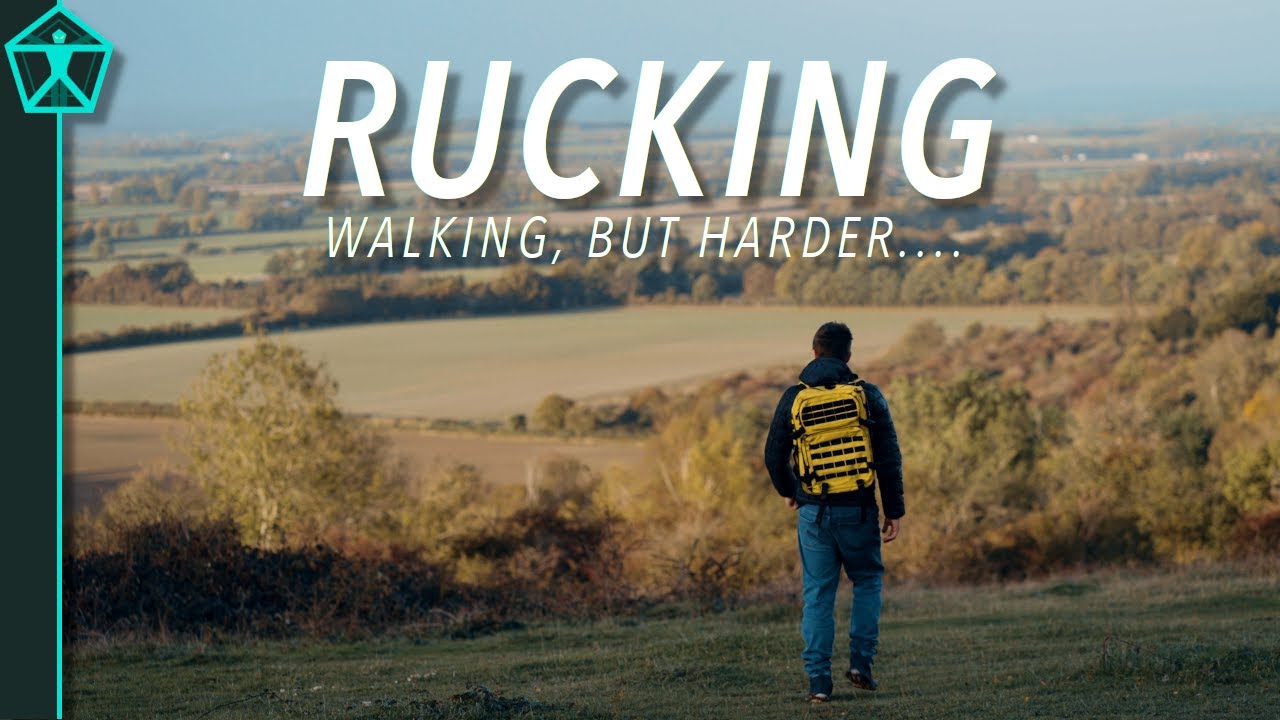
References:
- Peterson NE, Bate DA, Macintosh JL, Trujillo Tanner C. Wearable Activity Trackers That Motivate Women to Increase Physical Activity: Mixed Methods Study. JMIR Form Res. 2023;7:e48704. Published 2023 Dec 14. doi:10.2196/48704
